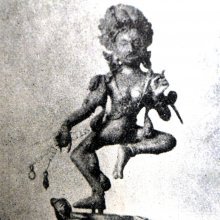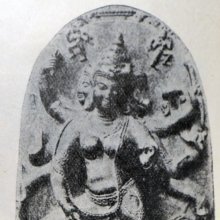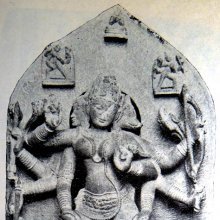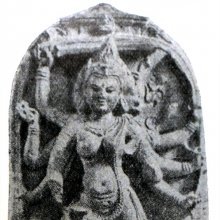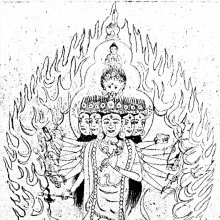Vajravetali, Vajravetālī, Vajra-vetali: 2 definitions
Introduction:
Vajravetali means something in Buddhism, Pali, Hinduism, Sanskrit. If you want to know the exact meaning, history, etymology or English translation of this term then check out the descriptions on this page. Add your comment or reference to a book if you want to contribute to this summary article.
Images (photo gallery)
In Buddhism
Tibetan Buddhism (Vajrayana or tantric Buddhism)
Source: archive.org: The Indian Buddhist IconographyVajravetālī (वज्रवेताली) is a variety of Mārīcī: one of the various emanations of Vairocana, as mentioned in the 5th-century Sādhanamālā (a collection of sādhana texts that contain detailed instructions for rituals).—Her Āsana is the ālīḍha; her Appearance is terrible; she has six faces and twelve arms.—When six-faced and twelve-armed, Mārīcī is invoked in three different forms and under three different names: Vajradhātvīśvarī Mārīcī. Uḍḍiyāna Mārīcī, and Vajravetālī. These three forms are classed together here because of their marked resemblance. They differ however in minor details and in respect of the weapons they carry in their hands.
Vajravetālī is described in the Sādhanamālā as follows:—
[The features that are common to all the three may be summarised from the Sādhanas as follows. They are all endowed with six faces and twelve arms. The first five faces are respectively of red, blue, green, yellow and white colour. The face on the top is misshapen like that of a sow, and is blue in colour. All the three are said to reside in the womb of a Caitya; they stand in the ālīḍha attitude and bear the image of Vairocana on the crown. They present a terrifying spectacle with three eyes, protruding tongue, bare fangs, serpents for ornaments and garments of tiger-skin.
Vajravetālī in one of her right hands holds the crossed double thunderbolt instead of the goad or the cakra, and in one of the left the noose instead of the kapāla or the khaṭvāṅga-kapāla.]

Tibetan Buddhism includes schools such as Nyingma, Kadampa, Kagyu and Gelug. Their primary canon of literature is divided in two broad categories: The Kangyur, which consists of Buddha’s words, and the Tengyur, which includes commentaries from various sources. Esotericism and tantra techniques (vajrayāna) are collected indepently.
Languages of India and abroad
Sanskrit dictionary
Source: Cologne Digital Sanskrit Dictionaries: Edgerton Buddhist Hybrid Sanskrit DictionaryVajravetālī (वज्रवेताली).—name of a goddess: Sādhanamālā 352.10.
Sanskrit, also spelled संस्कृतम् (saṃskṛtam), is an ancient language of India commonly seen as the grandmother of the Indo-European language family (even English!). Closely allied with Prakrit and Pali, Sanskrit is more exhaustive in both grammar and terms and has the most extensive collection of literature in the world, greatly surpassing its sister-languages Greek and Latin.
See also (Relevant definitions)
Partial matches: Vajra, Vetali.
Full-text: Uddiyanamarici, Vajradhatvishvari, Ashtabhujakurukulla.
Relevant text
Search found 2 books and stories containing Vajravetali, Vajravetālī, Vajra-vetali, Vajra-vetālī; (plurals include: Vajravetalis, Vajravetālīs, vetalis, vetālīs). You can also click to the full overview containing English textual excerpts. Below are direct links for the most relevant articles:
Guhyagarbha Tantra (with Commentary) (by Gyurme Dorje)
Text 16.3 (Commentary) < [Chapter 16 (Text and Commentary)]
Chapter 16 - Emanation of the Maṇḍala of Buddha-speech < [Chapter 16 (Text and Commentary)]
Text 15.27 (Commentary) < [Chapter 15 (Text and Commentary)]
The Indian Buddhist Iconography (by Benoytosh Bhattachacharyya)
